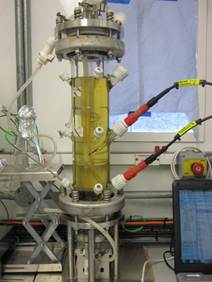|
Intensification of Biobutanol
Production
Biobutanol is a high value
biofuel and potentially a better fuel extender
than ethanol. The market demand is expected to
increase dramatically, if biobutanol can be
produced economically via the ABE (acetone,
butation, ethanol) fermentation. ABE
fermentation performed by Clostridium species
can be divided into two distinct phases,
acidogenic and solventogenic phases. Acetic acid
and butyric acid were produced during the
acidogenic phase, and after that acetone,
butanol and ethanol were produced during
solventogenic phase. In general, the biphasic
metabolism of Clostridium species is directly
associated with cell growth status.
Exponentially growing cells mainly produce
acids, while solvent is usually produced when
cells enter the late exponential phase. If
solvent production could be initiated in early
exponential phase, the solvent productivity
might be increased as the fermentation time
would be shortened. In industry, established
fermentation technologies are using several
parallel static vessels in staggered sequence to
provide a steady flow of fermentation broth and
to overcome inhibition. This requires a huge
floor space to accommodate multiple process
equipment which leads to increase in capital
cost. In addition, several intrinsic problems
(such as low solvent yield, expensive raw
material and costly recovery process) also
contribute to the incompetence of this
fermentation compared to the chemical route.
One way to develop an
economic production route of this ABE
fermentation is through intensification of the
fermentation process to improve solvent yield
and productivity. In this work, a novel
intensified bioreactor called the oscillatory
baffled bioreactor (OBB) was evaluate for this
process (Figure 1).

Fig. 1 - A 2 L Batch oscillatory baffled bioreactor
This novel bioreactor works
by oscillating the fluid in a baffled column,
thereby producing uniform efficient mixing
throughout the bioreactor via eddy generation
due to the interaction between the orifice-type
baffles and the periodically reversing flow. The
resultant radial and axial velocities are of the
same magnitude; resulting in uniform mixing in
each inter-baffle region, along the length of
the column. One particular advantage of the OBB
is for performing ‘long’ reactions (such as
fermentations) in a more compact design than
conventional tubular plug flow reactors. A
further advantage for the ABE fermentation could
be that the OBB provides relatively low shear,
uniform mixing, thereby achieving homogenous
conditions, with less cell damage than
comparable stirred tank reactors.
For more information please
contact Prof Adam Harvey.
|